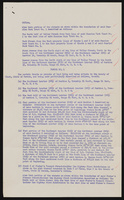Search the Special Collections and Archives Portal
Search Results
Margo Mansergh Papers
Identifier
Abstract
The Margo Mansergh Papers (approximately 1920-2010) document the life of former showgirl and dancer Margaret "Margo" Mansergh Tomaszewski. Materials include photographs of Margo modeling, backstage at various shows, portraits, and personal family photographs as well as programs from her international career performing in the Lido de Paris and Pigalle Nightclub in London, as well as a number of shows in Las Vegas, Nevada, such as Vive Les Girls, Casino de Paris, Minsky's Burlesque, and Lido de Paris at the Stardust. The collection contains materials from Mansergh's modeling career, including photographs, book covers, and images of her as an extra in films. Digital images from the closing Stardust performance and an event for Miss Bluebell are also found in the collection.
Archival Collection
Jack Schofield Papers
Identifier
Abstract
The Jack Schofield Papers are comprised of Dr. Jack Lund Schofield's scrapbooks, photographs, and awards from 1968 to 2014. Dr. Schofield was a Nevada System of Higher Education (NSHE) regent, member of the Nevada legislature, and teacher. The scrapbooks document Schofield's involvement with the University of Nevada, Las Vegas (UNLV) Aerospace program from the 1960s to the 1990s. The awards and photographs are from NSHE and document Schofield's involvement as a regent.
Archival Collection
UNLV Libraries Collection on Claes Oldenburg's Flashlight Sculpture
Identifier
Abstract
The UNLV Libraries Collection on Claes Oldenburg's
Archival Collection
Boardwalk Hotel and Casino Records
Identifier
Abstract
The Boardwalk Hotel and Casino Records date from 1993 to 2005 and contain administrative files, gaming projects and systems files, promotional photographs, advertisements, and audiovisual materials pertaining to the Boardwalk Hotel and Casino. The collection also contains material for the Boardwalk under its various names, including the Boardwalk Hotel and Casino, Viscount Hotel, and Holiday Inn Casino Boardwalk.
Archival Collection
Syphus-Bunker Papers
Identifier
Abstract
The Syphus-Bunker Papers date from 1891 to 1994, with the majority of the collection consisting of correspondence between Mary Etta Syphus and John Mathieson Bunker from 1891 to 1895. The collection also contains correspondence from friends and relatives, and documentation related to Mary Etta Syphus' attendance at Brigham Young Academy Church Normal Training School. Other materials include family history information and two color photographs of family homes. The collection also includes typed transcripts of the correspondence.
Archival Collection
Dr. Ruben Acherman oral history interview
Identifier
Abstract
Oral history interview with Ruben Acherman conducted by Monserrath Hernandez and Laurents Bañuelos-Benítez on July 18, 2019 for the Latinx Voices of Southern Nevada Oral History Project. In this interview, Acherman discusses growing up in Palmira, Colombia, where his father emigrated to from Romania. He talks about how accepted he felt in a Catholic community, moving to Cali, Colombia to study medicine, and describes completing his rural residency in San Pedro, Colombia. Acherman then recalls specializing in cardiology at the University of Southern California (USC). Later, Acherman explains why he chose to specialize in cardiology, his interests in pediatric cardiology, and his inability to continue studying due to the lack of financial stability and his immigration status. Acherman describes his move to the Summerlin residential community in Las Vegas, Nevada after being offered a position to work for Dr. Bill Evans in 2001, and compares the differences in health care between the United States and Columbia. Lastly, Acherman discusses his first balloon dilation procedure and talks about the illustrations he has created in cardiology textbooks.
Archival Collection
Richard W. Bunker oral history interviews
Identifier
Abstract
Oral history interviews with Richard W. Bunker conducted by Stefani Evans and Claytee D. White on July 18 2017, July 21, 2017, and September 28, 2017 for the Building Las Vegas Oral History Project. In this interview, Bunker discusses the history behind a wide range of events that affected the daily lives of Southern Nevadans. He talks about his role in a consolidation attempt between the Clark County and Las Vegas, Nevada governmental structures that was halted by the courts in 1975. Bunker then recalls working as a member and Chair of the Nevada Gaming Control Board and his work with various casinos and hotels including Circus Circus, the Dunes, and the Aladdin. He discusses replacing key people at the Gaming Control Board, and the Federal Bureau of Investigation’s (FBI) Operation Yobo sting. He then speaks fondly of his longtime friends Jim Gibson, Judge Lloyd George, and Jim Joyce. Lastly, Bunker discusses water rights, supply, and management issues in Nevada as it relates to the Nevada Resort Association, Las Vegas Valley Water District, Southern Nevada Water Authority, and the Colorado River Commission.
Archival Collection

Hernando Amaya oral history interview: transcript
Date
Archival Collection
Description
Oral history interview with Hernando Amaya conducted by Laurents Banuelos-Benitez, Marcela Rodriguez-Campo, and Barbara Tabach on October 18, 2018 and December 3, 2018 for the Latinx Voices of Southern Nevada Oral History Project. In this interview, Hernando Amaya talks about his childhood and education in Bogota, Colombia. He discusses his start in journalism as a young man and working for El Espectador, the Colombian national newspaper. He discusses his experiences reporting on the narco-terrorism occurring in Medellin, Colombia and how this eventually led to his immigration to the United States. Amaya moved to Las Vegas, Nevada in 2001 and continued his career in journalism by working for local Spanish speaking papers and websites. He relates his civic involvement in the Las Vegas area, his work as the president of the Colombian Association of Las Vegas, and various other civic engagements. As a journalist, he asserts the importance of knowing one's culture, storytelling, learning history, and being active in the community.
Text

Transcript of interview with George Pollak by Claytee White, May 25, 2010
Date
Archival Collection
Description
George was raised in Mattapan, a suburb of Boston, by his mother and father. George had four siblings and was the second youngest. George shares fond memories of growing up and playing softball and tennis in the neighborhood park with his numerous friends. George could listen to a song on the radio and play it on the piano by ear when he was as young as four years old. George had several jobs to earn money growing up, including working in a record store and as a busboy. Eventually George and his brother joined a trio with Steve Harrington and performed in clubs. In 1958, George joined his brother and Paulette Richards in Las Vegas where they had a contract to play at El Rancho Hotel & Casino where they played until it was destroyed by fire. Following the fire, George and his brother parted ways and each did their own thing. In the 1960s, George began playing with the band at Caesars Palace. George used his background in accounting to do some bookkeeping and payroll for some of the ban
Text

